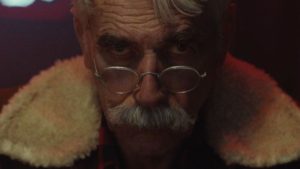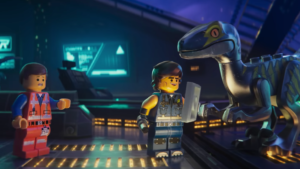 We all live with the weight of our life’s choices. Some of those choices we seem to forget about by moving on with our lives. Others linger with us for a long time, perhaps even the rest of our lives. They feel like a dull numbness, a residual insecurity we can’t shake. For some, rather than being well-acquainted with negative emotions, they have masked them with nostalgia or the veneer that everything is awesome and always joyful. Our ways of dealing with life are as diverse as the world’s population. To this end, two seemingly disparate films give us fodder for our exploration of this phenomenon: Robert Krzykowski’s The Man Who Killed Hitler and Then the Bigfoot and Mike Mitchell’s The Lego Movie 2: The Second Part.
We all live with the weight of our life’s choices. Some of those choices we seem to forget about by moving on with our lives. Others linger with us for a long time, perhaps even the rest of our lives. They feel like a dull numbness, a residual insecurity we can’t shake. For some, rather than being well-acquainted with negative emotions, they have masked them with nostalgia or the veneer that everything is awesome and always joyful. Our ways of dealing with life are as diverse as the world’s population. To this end, two seemingly disparate films give us fodder for our exploration of this phenomenon: Robert Krzykowski’s The Man Who Killed Hitler and Then the Bigfoot and Mike Mitchell’s The Lego Movie 2: The Second Part.
In The Man Who Killed Hitler… we enter the story of a man weighed down by the guilt of his past choices, resigning himself to a simple existence with his dog. As a young soldier, Calvin Barr (Aidan Turner) spent his time during World War 2 infiltrating the Nazi ranks and, in the end, making his way into Adolf Hitler’s office and assassinating him. Despite this being one of the most evil men—if not the most evil man—in modern world history, Calvin—now an old man played by Sam Elliot—lives the rest of his life with immense guilt over taking another human life. In addition, he lives with a kind of resigned acceptance of the fact that Maxine, a young lady whom he nearly married before the war, died young and he missed out on the love of a beautiful woman for the sake of his mission. He seems content with the life he has constructed for himself, with a daily rhythm of going to the local bar and spending time relaxing in front of the television, resigned to his armchair with his dog by his side. From time to time, he will visit his younger brother, who serves as the town barber.
 This simple existence is interrupted by a visit from two government agents with one request: come out of a long retirement to help them kill a disease-carrying creature which threatens life as we know it – Bigfoot. Sitting at this dinner table hearing their pitch to help his government one more time, we see Calvin emotionally recount his previous mission, misty-eyed and words dripping with both regret and deep-seated anger. Lest we think this absurdity turns this story towards B-movie schlock, nothing could be further from the truth. After getting past his initial reservation—of killing another living creature—and finally accepting the mission, what unfolds is the character study of a broken man, one who wants to be left alone to live out the rest of the days with nothing more to weigh on his conscience.
This simple existence is interrupted by a visit from two government agents with one request: come out of a long retirement to help them kill a disease-carrying creature which threatens life as we know it – Bigfoot. Sitting at this dinner table hearing their pitch to help his government one more time, we see Calvin emotionally recount his previous mission, misty-eyed and words dripping with both regret and deep-seated anger. Lest we think this absurdity turns this story towards B-movie schlock, nothing could be further from the truth. After getting past his initial reservation—of killing another living creature—and finally accepting the mission, what unfolds is the character study of a broken man, one who wants to be left alone to live out the rest of the days with nothing more to weigh on his conscience.
While guilt and regret plague Calvin Barr, The Lego Movie 2 presents us with a character caught in the tension of who he thinks he is and who he wants to be. Emmet Brickowski (voiced by Chris Pratt) and Lucy (voiced by Elizabeth Banks) live in a post-invasion world where Lego Duplo appeared in their world five years prior, ending the time where “everything is awesome.” While Emmet wants to get back to the joy of a pre-invasion world, Lucy struggles to see how Emmet cannot face how everything has changed, the life he seemingly wants to preserve no longer exists. As Emmet shows Lucy his new house, which she thinks is a waste of time, this new world meets them face-to-face. The Lego Duplo aliens come back to their world with Duplo General Mayhem announcing their queen wants to marry the leader of the city, now known as Apocalypseburg. In the process, Emmet’s new house is destroyed, and the General takes several of his friends to the Systar System to be guests at this “special wedding.” In the process of traveling to rescue his friends, Emmet encounters Rex Dangervest—who we later learn is a future version of Emmet himself.

When they first meet, we encounter a clash of identity, two different visions of masculinity. With Rex, we get the stereotypical American vision of masculinity: being a go-getter who is tough and doesn’t let his emotions get in the way. With Emmet, we find a vision of masculinity which is more attuned to his emotional life but also wanting to be seen as strong and capable of accomplishing great tasks. Yet both men, in their own ways, face insecurities. Rex’s insecurity is seen in his self-sufficiency and his own desire to see his anticipated outcome—one he can control—come to fruition. With Emmet, he lives in the tension between his true self and his desire to be seen as someone like Rex, especially in the eyes of Lucy. This desire to have a certain kind of perceived self-confidence lends itself to a major misunderstanding and to Emmet becoming susceptible to deception. Rex is actually not a good guy but, instead, a revenge-seeking narcissist and the Duplo aliens are in fact wanting peace, not war. Emmet’s self-conception nearly leads to choices which would have been disastrous for all those he loved.
In both The Man Who Killed Hitler… and The Lego Movie 2, we are invited to consider the ways the choices we make in life bear down on us, demanding certain emotional commitments from which we may wish to be freed. For both Calvin and Emmet, other peoples’ lives were in their hands. There is a heaviness to such a reality that many of us cannot truly fathom. For Calvin, the weight of taking away life left him emotionally numb and settled into a kind of resigned cynicism where he found comfort in doing the same things day in and day out. With Emmet, the weight of desiring to belong and of being seen in a certain way by those around him clouded his judgment leading to him being unable to see his situation rightly and respond appropriately. Now certainly wanting to belong is not negative. In fact, human beings have a basic need to belong and feel connected to others. What is at play here, however, is when that good desire is clouded by insecurity and a fragile sense of masculinity.
 What both films offer is a reminder of the complexity of human memory and emotion. For many, how they come across in public may only be a cover for hiding the deep emotional wounds they carry with them each day, ones they may very well be afraid to reveal to others. For Calvin, he found a semblance of peace in the love and understanding of his younger brother. For Emmet, hearing Lucy’s affirmation of who he was and how she was wrong about him freed him up to walk in a self-confidence mostly absent in the previous half of the film. In these cinematic worlds, we get a glimpse into our own – the places where we come across all different manners of Calvins and Emmets, ones looking for peace, belonging, and some relief from the burden of being human in this world – where we too feel the sting of death and the weight of yesteryear’s decisions. While we may not be tasked with killing Bigfoot or saving a planet full of talking Legos, we can live our ordinary moments with a sacramental imagination, seeing the presence of divine transcendence in the simple things and, even despite life’s regrets, we can still move on in hope.
What both films offer is a reminder of the complexity of human memory and emotion. For many, how they come across in public may only be a cover for hiding the deep emotional wounds they carry with them each day, ones they may very well be afraid to reveal to others. For Calvin, he found a semblance of peace in the love and understanding of his younger brother. For Emmet, hearing Lucy’s affirmation of who he was and how she was wrong about him freed him up to walk in a self-confidence mostly absent in the previous half of the film. In these cinematic worlds, we get a glimpse into our own – the places where we come across all different manners of Calvins and Emmets, ones looking for peace, belonging, and some relief from the burden of being human in this world – where we too feel the sting of death and the weight of yesteryear’s decisions. While we may not be tasked with killing Bigfoot or saving a planet full of talking Legos, we can live our ordinary moments with a sacramental imagination, seeing the presence of divine transcendence in the simple things and, even despite life’s regrets, we can still move on in hope.
